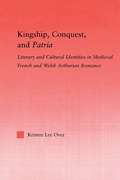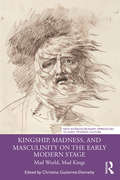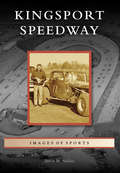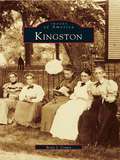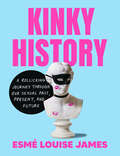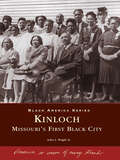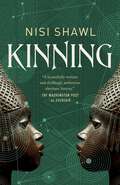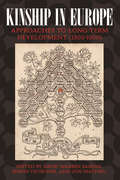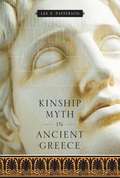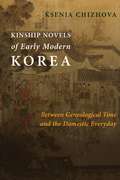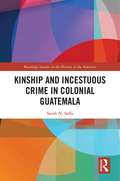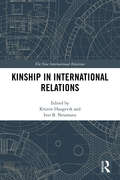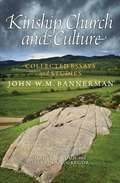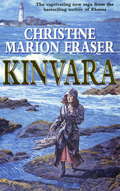- Table View
- List View
Kingship, Conquest, and Patria (Studies in Medieval History and Culture #35)
by Kristen Lee OverFirst Published in 2005. Routledge is an imprint of Taylor & Francis, an informa company.
Kingship, Madness, and Masculinity on the Early Modern Stage: Mad World, Mad Kings (New Interdisciplinary Approaches to Early Modern Culture)
by Christina Gutierrez-DennehyKingship, Madness, and Masculinity examines representations of mad kings in early modern English theatrical texts and performance practices. Although there have been numerous volumes examining the medical and social dimensions of mental illness in the early modern period, and a few that have examined stage representations of such conditions, this volume is unique in its focus on the relationships between madness, kingship, and the anxiety of lost or fragile masculinity. The chapters uncover how, as the early modern understanding of mental illness refocused on human, rather than supernatural, causes, public stages became important arenas for playwrights, actors, and audiences to explore expressions of madness and to practice diagnoses. Throughout the volume, the authors engage with the field of disability studies to show how disability and mental health were portrayed on stage and what those representations reveal about the period and the people who lived in it. Altogether, the essays question what happens when theatrical expressions of madness are mapped onto the bodies of actors playing kings, and how the threat of diminished masculinity affects representations of power. This volume is the ideal resource for students and scholars interested in the history of kingship, gender, and politics in early modern drama.
Kingsholt
by Susan HollidaySam and Chloe never thought they would spend the summer holidays fighting a battle against the dark past that haunts Kingsholt, a mansion inherited by Chloe's parents. A long time ago the Vikings burnt down the monastery that was built near Kingsholt. A few monks who escaped hid the monastery's treasure and dug a pit in which to bury the slaughtered monks. They swore that if anyone opened up the pit and used it for other purposes a darkness would fall over the area. Nimbus,an obsessive one-time circus hypnotist and acrobat, lives with his wife and two children in a cottage in the woods of Kingsholt. He opens up the pit and uses it for all his rubbish. With death, kidnap and madness ensuing, can Sam and Chloe and their guardian Aidan, bring back the light to Kingsholt?
Kingsley Manor: The Complete Series
by Shalaby, Amanda L. V.Gothic fans will enjoy this dark Regency duology featuring love lost and found at stately Kingsley Manor.Rhianna: Alone after the death of her parents, nineteen-year-old Rhianna Braden must give up her life and beaus to move to Kingsley Manor. Her uncommon beauty captures the attention of the dashing Lord Thayne Brighton, but Rhianna is certain, despite their mutual attraction, that he will never choose her over his wealthy intended. Meanwhile, Lady Lydia Kingsley suspects her husband Guilford’s attention to the new family member under their roof has led to an affair between them. Caught in the web of desire and lies, Rhianna finds her own life in danger when the truth inevitably comes to light. After all, family secrets are not meant to be kept. Audra: Wealthy heiress Audra Kingsley agrees to go along with her father’s insistence on a London season, even though she’s always been promised to marry her neighbor and childhood sweetheart, Lord Crispin Brighton. She heads to London with her patroness, the eccentric Lady Sutherland, who is determined to show the young debutante that she has more options than a second son. Unfortunately, Audra is also the object of a secret admirer’s obsession who plans to compromise her into an unwanted marriage. Can a country girl thwart the city Ton to return to her beloved? Sensuality Level: Behind Closed Doors
Kingsnorth Airship Station: In Defence of the Nation
by Tina BilbeKingsnorth Airship Station played a vital role during the First World War, developing airships which successfully protected the fleet from submarine attack. It was the proud boast of the Airship Service that no vessels accompanied by one of their airships were lost to submarine attack. This book tells the story of Kingsnorth, exploring the development of the station, the challenges faced and overcome, the people who contributed to the station’s success and how the station and its legacy have changed the local area. Contemporary accounts and pictures bring this story to life, whether for the local historian, military enthusiast or a relative linked with Kingsnorth.
Kingsport Speedway (Images of Sports)
by David M. McgeeKingsport Speedway has hosted many of racing's greatest drivers, whether its track surface was asphalt, red clay, or brushed concrete. The short track, located in East Tennessee, has undergone dramatic changes since 1965 in attempts to keep pace with an ever-evolving motorsports landscape while entertaining three generations of fans. Hall of Fame members have raced and won at Kingsport Speedway, as did a contingent of regional stars. Today, Kingsport Speedway features weekly programs of NASCAR's Whelen All-American Series, which crowns track, state, regional, and national champions.
Kingston
by Betty J. CotterPerhaps no village in Rhode Island can boast the history of Kingston, or "Little Rest" as it was called. Once a seat of government (its library was one of Rhode Island's five state houses), Kingston has been home to some of the state's most illustrious residents as well as the now sprawling University of Rhode Island. A center of intellectual life long before the university began, Kingston was characterized by social, civic, and dramatic clubs, academies for both men and women, taverns for the weary traveler, and an imposing church atop Kingston Hill whose influence was felt broadly in the village.More than 200 photographs take the reader back tonineteenth-century Kingston, where Stephen Knowles waits atop his carriage to take travelers to Kingston Station, hat maker Cyrus French regales the menfolk in Joe Reynolds's tavern with his expansivestories, and the villagers gather on a summer evening to listen to a musicale on the library's lawn. Within Kingston's pages, the reader can meet people like Solomon Fayerweather, the village blacksmith and church sexton with a unique wisdom about village doings; and Quaker Billy Rose, whose fine weaving work was sought by the likes of Mrs.Theodore Roosevelt. See the familiar, Colonial-style houses that still line Kingstown Road as well as others that have fallen victim to the wrecking ball. Photographs of nearby "Biscuit City" and West Kingston are also included. These photographs, mostly from the collection of the Pettaquamscutt Historical Society, chronicle church, school, and business life in this picturesque village that has played such an important role in Rhode Island's history.
Kingston by Starlight
by Christopher John FarleyIrish-born Anne Bonny is only a teenager when she is left destitute by her mother’s death. Abandoned by her father, she seems destined to be forgotten by the world. But Anne chooses to seek her fortune in the lush tropics of the colonial West Indies, where she passes herself off as a young man named Bonn. She finds work as a ship’s hand, sailing under the command of Calico Jack Rackam, a notorious and charismatic pirate with a bounty on his head. Calico Jack has his heart set on raiding the Madrid Galleon, the richest ship in the Caribbean, which sails from Kingston laden with Cuban gold and Jamaican rum. Bonn is entranced by the sea and by the ship’s violent crew, which includes a mysterious swordfighter named Read, who, it turns out, has a secret life of his own. Calico Jack soon discovers Bonn’s and Read’s true identities, but it is only when the three pirates are captured that their darkest secrets begin to surface. In the shadow of the gallows, a strange twist of fate reveals a shocking betrayal that may save Bonn from death, while permanently changing everything she has known about her past and the world around her. Gorgeously written and full of mystery, intrigue, and startling revelations about gender, race, history, and the human heart, Kingston by Starlight is a once-in-a-lifetime read. From the Trade Paperback edition.
Kinky Gazpacho
by Lori TharpsMagazine writer and editor Lori Tharps was born and raised in the comfortable but mostly White suburbs of Milwaukee, Wisconsin, where she was often the only person of color in her school and neighborhood. At an early age, Lori decided that her destiny would be discovered in Spain. She didn't know anyone from Spain, had never visited the country, and hardly spoke the language. Still, she never faltered in her plans to escape to the Iberian Peninsula. Arriving in the country as an optimistic college student, however, Lori soon discovers Spain's particular attitude toward Blackness. She is chased down the street by the local schoolchildren and pointed at incessantly in public, and her innocent dreams of a place where race doesn't matter are shattered. The story would end there, except Lori meets and marries a Spaniard, and that's when her true Spanish adventure really begins. Against the ancient backdrops of Cádiz and Andalucía, Lori starts the intricate yet amusing journey of rekindling her love affair with Spain and becoming a part of her new Spanish family. From a grandmother who spies on her to a grandfather who warmly welcomes her to town with a slew of racist jokes, the close-knit clan isn't exactly waiting with open arms. Kinky Gazpacho tells the story of the redeeming power of love and finding self in the most unexpected places. At its heart, this is a love story. It is a memoir, a travel essay, and a glimpse into the past and present of Spain. As humorous and entertaining as such favorite travel stories as Under the Tuscan Sun, this book also unveils a unique and untold history of Spain's enduring connection to West Africa. Kinky Gazpacho celebrates the mysticism of travel and the joys of watching two distinct cultures connect and come together.
Kinky History: A Rollicking Journey through Our Sexual Past, Present, and Future
by Esmé Louise JamesA provocative journey through human sexual history, packed with fun factoids and forgotten stories, from the historian and storyteller behind Kinky History, @esme.louisee on TikTokContrary to popular belief, our predecessors had all sorts of obscene hobbies long before Christian Grey hit the scene. In this enlightening romp, learn about the first instances of homosexuality on record from the ancient world and the diverse history of nonbinary gender; encounter a thousand years&’ worth of hilarious and horrifying contraceptive methods; consider the positive and negative effects of the widespread availability of pornography in the digital age—and how our relationship to it changed during the pandemic; take a sneaky riffle through centuries of bedside drawers; and discover the dirty little secrets of luminaries such as Julius Caesar, James Joyce, Albert Einstein, and Virginia Woolf. Esmé Louise James also identifies the key tipping points that directly inform current beliefs around sex to place the past in conversation with the present. By educating ourselves about the weird, wonderful, and varied spectrum of human sexuality and experience, we can normalize and destigmatize sex, write people of marginalized sexual identities back into the pages of history, and build toward a more liberated future.
Kinloch: Missouri's First Black City (Black America Series)
by John A. Wright Sr.Located just outside of St. Louis, Kinloch was once a community locked off from the rest of the area by natural and man-made barriers. In spite of a lack of financial resources, it once provided its residents with a school district, city hall, post office, business district, and recreational facilities. Residents will recognize Dunbar Elementary, the oldest school for blacks in St. Louis County, Holy Angels, the oldest continuing black parish in the St. Louis Archdiocese, as well as former residents Congresswoman Maxine Waters and political activist Dick Gregory. Eventually, due to insufficient revenue, this once thriving community fell into decline, and is now struggling to keep its small town values and ideals alive.
Kinning (Everfair #2)
by Nisi ShawlNamed a Best Fantasy and Sci-Fi Book of The Year by Elle!Kinning, the sequel to Nisi Shawl’s acclaimed debut novel Everfair, continues the stunning alternate history where barkcloth airships soar through the sky, varied peoples build a new society together, and colonies claim their freedom from imperialist tyrants.The Great War is over. Everfair has found peace within its borders. But our heroes’ stories are far from done.Tink and his sister Bee-Lung are traveling the world via aircanoe, spreading the spores of a mysterious empathy-generating fungus. Through these spores, they seek to build bonds between people and help spread revolutionary sentiments of socialism and equality—the very ideals that led to Everfair’s founding.Meanwhile, Everfair’s Princess Mwadi and Prince Ilunga return home from a sojourn in Egypt to vie for their country’s rule following the abdication of their father King Mwenda. But their mother, Queen Josina, manipulates them both from behind the scenes, while also pitting Europe’s influenza-weakened political powers against one another as these countries fight to regain control of their rebellious colonies.Will Everfair continue to serve as a symbol of hope, freedom, and equality to anticolonial movements around the world, or will it fall to forces inside and out?At the Publisher's request, this title is being sold without Digital Rights Management Software (DRM) applied.
Kinross Saga: Trade Winds, Highland Storms, Monsoon Mists
by Christina CourtenayThree intrepid Highlanders pursue love and fortune across the globe in these “majestic” historical romances (Elder Park Book Reviews). Steeped in “fascinating history, with plenty of chemistry and action to go around,” each novel in this saga follows a member of the Kinross clan on a voyage into the heart of the woman he loves (RT Book Reviews). From Scotland to Sweden, China, India, and beyond, these intrepid Highlanders discover that romance is the greatest adventure of all. Trade Winds It is 1732. Former gambler Killian Kinross sails to Sweden in pursuit of an honest trade, only to be propositioned with a marriage of convenience that leads him out to the high seas and into the arms of his true love.Highland Storms It is 1754. Brice Kinross leaves Sweden to reclaim his family’s Highland estate—only to discover a mystery waiting to be solved, and a beautiful housekeeper who just might be the love he was destined for. Monsoon Mists It is 1759. Jamie Kinross leaves Sweden for India to make his fortune in the gem trade. There, he encounters the fiercely independent Zarmina Miller. Both are embroiled in a sinister ransom plot, and soon realize they are also bound together in love . . .
Kinship In Europe
by David Warren Sabean Jon Mathieu Simon TeuscherSince the publication of Philippe Ariès's book, Centuries of Childhood, in the early 1960s, there has been great interest among historians in the history of the family and the household. A central aspect of the debate relates the story of the family to implicit notions of modernization, with the rise of the nuclear family in the West as part of its economic and political success. During the past decade, however, that synthesis has begun to break down. Historians have begun to examine kinship - the way individual families are connected to each other through marriage and descent - finding that during the most dynamic period in European industrial development, class formation, and state reorganization, Europe became a "kinship hot" society. The essays in this volume explore two major transitions in kinship patterns - at the end of the Middle Ages and at the end of the eighteenth century - in an effort to reset the agenda in family history.
Kinship Myth in Ancient Greece
by Lee E. PattersonIn ancient Greece, interstate relations, such as in the formation of alliances, calls for assistance, exchanges of citizenship, and territorial conquest, were often grounded in mythical kinship. In these cases, the common ancestor was most often a legendary figure from whom both communities claimed descent. In this detailed study, Lee E. Patterson elevates the current state of research on kinship myth to a consideration of the role it plays in the construction of political and cultural identity. He draws examples both from the literary and epigraphical records and shows the fundamental difference between the two. He also expands his study into the question of Greek credulity--how much of these founding myths did they actually believe, and how much was just a useful fiction for diplomatic relations? Of central importance is the authority the Greeks gave to myth, whether to elaborate narratives or to a simple acknowledgment of an ancestor. Most Greeks could readily accept ties of interstate kinship even when local origin narratives could not be reconciled smoothly or when myths used to explain the link between communities were only "discovered" upon the actual occasion of diplomacy, because such claims had been given authority in the collective memory of the Greeks.
Kinship Novels of Early Modern Korea: Between Genealogical Time and the Domestic Everyday (Premodern East Asia: New Horizons)
by Ksenia ChizhovaThe lineage novel flourished in Korea from the late seventeenth to the early twentieth century. These vast works unfold genealogically, tracing the lives of several generations. New storylines, often written by different authors, follow the lives of the descendants of the original protagonists, offering encyclopedic accounts of domestic life cycles and relationships. Elite women transcribed these texts—which span tens and even hundreds of volumes—in exquisite vernacular calligraphy and transmitted them through generations in their families.In Kinship Novels of Early Modern Korea, Ksenia Chizhova foregrounds lineage novels and the domestic world in which they were read to recast the social transformations of Chosŏn Korea and the development of early modern Korean literature. She demonstrates women’s centrality to the creation of elite vernacular Korean practices and argues that domestic-focused genres such as lineage novels, commemorative texts, and family tales shed light on the emergence and perpetuation of patrilineal kinship structures. The proliferation of kinship narratives in the Chosŏn period illuminates the changing affective contours of familial bonds and how the domestic space functioned as a site of their everyday experience. Drawing on an archive of women-centered elite vernacular texts, Chizhova uncovers the structures of feelings and conceptions of selfhood beneath official genealogies and legal statutes, revealing that kinship is as much a textual as a social practice. Shedding new light on Korean literary history and questions of Korea’s modernity, this book also offers a broader lens on the global rise of the novel.
Kinship and Incestuous Crime in Colonial Guatemala
by Sarah N. SaffaKinship and Incestuous Crime in Colonial Guatemala examines social relations in colonial Guatemala through the lens of incest. Using a combination of qualitative and quantitative analyses of incest trials from the Spanish secular courts, this study shows that incest codes were not homogenous nor were its various forms equally condemned. Further, incest codes and the criminal process impacted the articulation of kinship and contributed to the racialization of kin behavior. Colonial actors of all sorts were proficient at using these types of distinctions as they negotiated various crises in their lives. The models of relatedness created within incestuous crime ultimately foreshadowed changes in marriage proscriptions and continued racial polarization following independence from Spain. Overall, this study demonstrates how the lens of incest can add further nuance to our understanding of social relations in a given area. Incest codes force latent divisions between kin to the surface and can provide individuals with multiple avenues to creatively manage interpersonal relationships. They also afford a fruitful arena in which to explore social inequalities in society and mechanisms of culture change. This book will appeal to anyone interested in Latin America or engaged in the fields of kinship, gender, or sexuality studies.
Kinship and Marriage Among the Nuer
by E. E. Evans-PritchardSir Edward Evans-Pritchard's classic writings on the Nuer of southern Sudan have made them one of the most famous peoples in ethnographic literature. When the writings were first published half a century ago, they created a new agenda for social anthropology. Kinship and Marriage among the Nuer is the second of his trilogy on the society and culture of this pastoral people. It vividly portrays the experience of growing up in a Nuer community, describing daily life, marriage, sex, death, and birth. It also makes clear the essential difference between the discourse of political association and that of kinship, and shows the part played by the kinship system in Nuer society as a whole. Now published for the first time in paperback, this edition has a substantial introduction by Wendy James in which she assesses the importance of Evans-Pritchard's work and places it in the context of recent developments in social anthropology.
Kinship in International Relations (New International Relations)
by Iver B Neumann Kristin HaugevikWhile kinship is among the basic organizing principles of all human life, its role in and implications for international politics and relations have been subject to surprisingly little exploration in International Relations (IR) scholarship. This volume is the first volume aimed at thinking systematically about kinship in IR – as an organizing principle, as a source of political and social processes and outcomes, and as a practical and analytical category that not only reflects but also shapes politics and interaction on the international political arena. Contributors trace everyday uses of kinship terminology to explore the relevance of kinship in different political and cultural contexts and to look at interactions taking place above, at and within the state level. The book suggests that kinship can expand or limit actors’ political room for maneuvereon the international political arena, making some actions and practices appear possible and likely, and others less so. As an analytical category, kinship can help us categorize and understand relations between actors in the international arena. It presents itself as a ready-made classificatory system for understanding how entities within a hierarchy are organized in relation to one another, and how this logic is all at once natural and social.
Kinship, Capitalism, Change: The Informal Economy of the Navajo, 1868-1995 (Native Americans: Interdisciplinary Perspectives)
by Michael J. FrancisconiFirst Published in 1998. Routledge is an imprint of Taylor & Francis, an informa company.
Kinship, Church and Culture: Collected Essays and Studies by John W. M. Bannerman
by John W. BannermanA collection of the author&’s essays and studies on the Gaelic roots of Scotland. John Bannerman (1932-2008) saw the history of Scotland from a Gaelic perspective, and his outstanding scholarship made that perspective impossible to ignore. As a historian, his natural home was the era between the Romans and the twelfth century when the Scottish kingdom first began to take shape, but he also wrote extensively on the MacDonald Lordship of the Isles in the fourteenth and fifteenth centuries, while his work on the Beatons, the notable Gaelic medical kindred, reached into the early eighteenth century. Across this long millennium, Bannerman ranged and wrote with authority and insight on what he termed the &“kin-based society,&” with special emphasis upon its church and culture, and its relationship with Ireland. This collection opens with Bannerman&’s ground-breaking and hugely influential edition and discussion of Senchus fer nAlban (&“The History of the Men of Scotland&”), which featured in his Studies in the History of Dalriada (1974), now long out of print. Also included are all of his published essays, plus an essay-length study of the Lordship of the Isles, which first featured as an appendix in Late Medieval Monumental Sculpture in the West Highlands (1977). The book will be of interest to anyone wanting to know more about the Gaelic dimension to Scotland&’s past and present.&“A substantial, weighty tome, worth every penny of its price. Determination, earnestness, humor, and originality characterize all this work. A substantial intellectual treat brought gully into the scholarly light of day for a new generation.&” —Cambrian Medieval Celtic Studies
Kinsmen of Another Kind: Dakota-White Relations in the Upper Mississippi Valley 1650-1862
by Gary C. AndersonIn August 1862, the Dakota of Eastern Sioux resorted to armed conflict against the white settlers of southern Minnesota. This study uses an ethnohistorical approach to explain why the bonds of peace between the Dakota and the whites were suddenly broken. It shows how the Dakota concept of kinsmen affected the tribe's complex relationships with the whites. The Dakota were obliged to help their relatives by any means possible. Traders who were adopted or married into the tribe gained from this relationship, but had reciprocal responsibilities. After the 1820s, the trade in furs declined, more whites moved into the territory, and the Dakota became more economically dependent on the whites. When American officials and traders failed to fulfill their obligations, many Dakotas finally saw the whites as enemies to be driven from Minnesota. This edition includes a new introduction by the author, who comments on scholarly developments in the field of ethnohistory in the 19th century.
Kintu
by Jennifer Nansubuga MakumbiIn this epic tale of fate, fortune and legacy, Jennifer Makumbi vibrantly brings to life this corner of Africa and this colourful family as she reimagines the history of Uganda through the cursed bloodline of the Kintu clan. <P><P>The year is 1750. Kintu Kidda sets out for the capital to pledge allegiance to the new leader of the Buganda kingdom. Along the way he unleashes a curse that will plague his family for generations. Blending oral tradition, myth, folktale and history, Makumbi weaves together the stories of Kintu&’s descendants as they seek to break free from the burden of their past to produce a majestic tale of clan and country – a modern classic.
Kinvara
by Christine Marion FraserIt is December 1922, and the keepers of the Kinvara Light, an impressive lighthouse just off the rugged west coast of Scotland, are home for Christmas after three bleak months away from their families. Robert Sutherland, deputy head keeper, finds little comfort at home: his wife Hannah is embittered by her isolation, by the tragedy of her infant son's cerebral palsy and by her husband's long absences. Rob find solace in the arms of Morna Jean Sommero, whose warmth and love compensate for his sterile marriage.Christine Marion Fraser has created a vivid Scottish village and peopled it with memorable characters. The spirited and engaging folk of Kinvara, whose fates are shaped by the harsh landscape and the rugged coast on which they live, will move, entrance, and linger in the memory.'Christine Marion Fraser writes characters so real they almost leap out of the page...you would swear she must have grown up with them' Sun
Kinvara
by Christine Marion FraserIt is December 1922, and the keepers of the Kinvara Light, an impressive lighthouse just off the rugged west coast of Scotland, are home for Christmas after three bleak months away from their families. Robert Sutherland, deputy head keeper, finds little comfort at home: his wife Hannah is embittered by her isolation, by the tragedy of her infant son's cerebral palsy and by her husband's long absences. Rob find solace in the arms of Morna Jean Sommero, whose warmth and love compensate for his sterile marriage.Christine Marion Fraser has created a vivid Scottish village and peopled it with memorable characters. The spirited and engaging folk of Kinvara, whose fates are shaped by the harsh landscape and the rugged coast on which they live, will move, entrance, and linger in the memory.'Christine Marion Fraser writes characters so real they almost leap out of the page...you would swear she must have grown up with them' Sun
